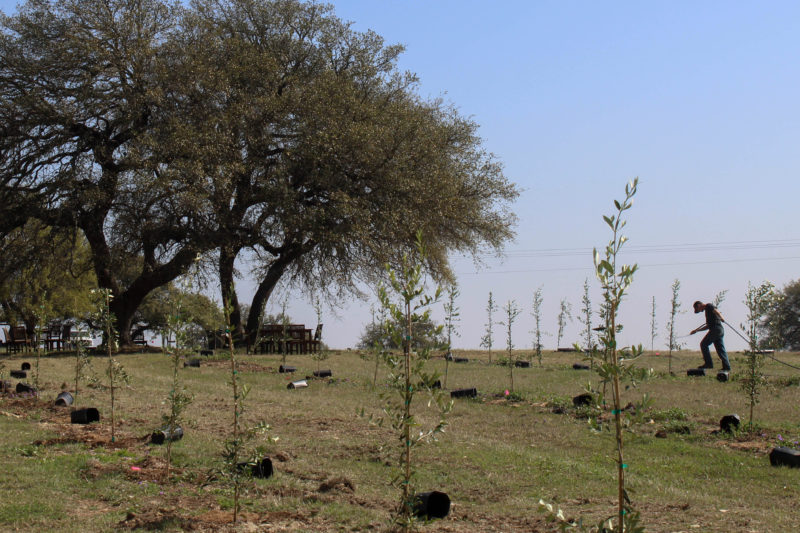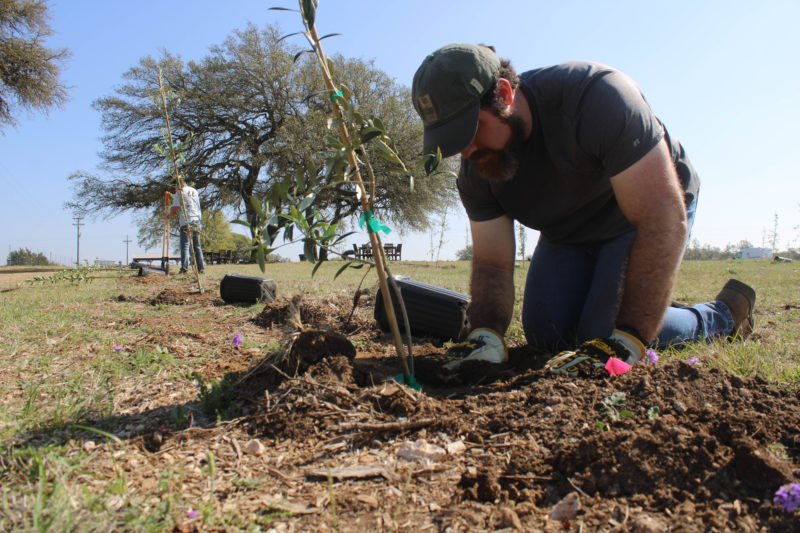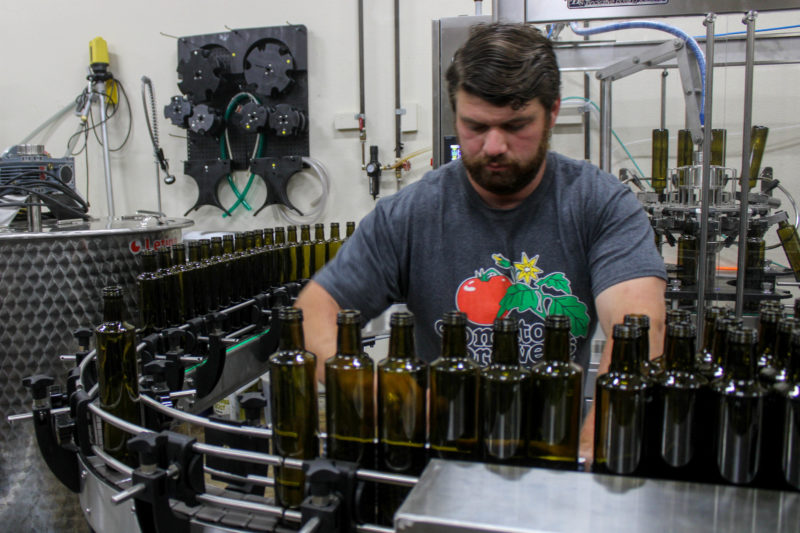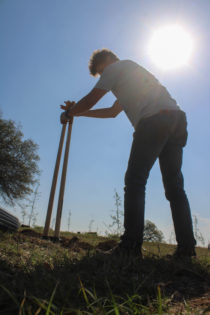Diversify or Die: Texas Olive Oil Industry on its Knees after 2021 Freeze
By Paula Levihn-Coon
Reporting Texas

Andrew Cox waters newly planted olive trees at Texas Hill Country Olive Company in Dripping Springs, Texas, on April 5, 2022. The aftermath of Winter Storm Uri devastated trees and left them unable to bear fruit so many growers had to replant. Madeleine Ortiz/Reporting Texas
John Gambini and his daughter Cara planted Texas Hill Country Olive Company’s first trees in Dripping Springs in 2009. Eleven years later, their orchard had its best harvest ever.
“That’s what olive trees should look like, with the branches hanging down with all the weight of the fruit pulling down. It looked like strings of pearls hanging on these trees,” said Stephen Janak, Texas A&M AgriLife Extension Service’s olive specialist. “They made more fruit per tree than I’ve ever seen in Texas.”
For many Texas olive growers, it seemed like their nascent industry had matured.
But then in 2021, Winter Storm Uri walloped the Texas olive industry.

One of the biggest challenges facing Texas olive growers is the weather, such as freezes which caused the death of this tree at Texas Hill Country Olive Company. Madeleine Ortiz/Reporting Texas
“There was not an olive in the entire state last year. None. Zero,” said Cathy Bernell, president of the Texas Association of Olive Oil and co-owner of Lone Star Olive Ranch in Madisonville. “I felt like somebody had told me they ran over my dog. It was accepting a death.”
Since the first olive orchards were planted in Texas in the 1990s, they have been damaged by hurricanes, drought and cold weather. Confused by mad temperature swings, trees have not set fruit.
These events have compelled some olive growers to leave the business.

Knox Alvarez, left, and Adam Bardshar, right, plant new olive trees at Texas Hill Country Olive Company in Dripping Springs, Texas, on April 5, 2022. The 17-acre orchard is family-owned and operated and includes an olive oil mill and restaurant. Madeleine Ortiz/Reporting Texas
After Uri, however, most have pruned trees that survived and are replanting thousands of others, taking the opportunity to select different varietals and to space trees differently to profit from lessons learned.
Most growers, however, are reevaluating their business models with an eye toward reducing the negative impact of Texas weather. They are embracing diversification — selling oil imported from other states or countries or finding new ways to use and market their orchards.
Given the challenges of growing olives in Texas, why carry on?
“It’s a risk that we’re willing to take because we feel like we need to have olives in the U.S.,” said Cara Gambini. “It is an important crop.”
Her father credits stubbornness for staying in the business. “The trees just need to get to a certain age to survive these events,” he said.

Anthony Grassia, orchard manager at Texas Hill Country Olive Company prepares bottles that will be filled with extra virgin olive oil. Madeleine Ortiz/Reporting Texas
The United States is the largest importer of olive oil, consuming 33% of the world’s production last year, according to the International Olive Council. California accounted for 95% of U.S.-produced olive oil, with Texas ranking second before Uri, according to the Olive Oil Times. But U.S. producers accounted for less than 5% of the nation’s olive oil consumption.
From the get-go, many Texas olive growers realized that making a living from olive farming alone would be difficult and supplemented their farming with other products or business enterprises.

Knox Alvarez digs a post for a new olive tree at Texas Hill Country Olive Company. Texas’ weather has forced many olive growers to supplement their sales with other ventures. Madeleine Ortiz/Reporting Texas
Before Uri, the Gambinis were growing olives in South Texas and augmenting olive oil sales with venue rentals, tours and a bistro at their Tuscany-like establishment. Now they are finalizing 10-year leases on four California orchards, adding 40 acres to the land they already farm. They are also considering other crops to grow in addition to olives.
Bernell and her partner, Christine McCabe, have provided milling, management and consulting services to olive growers in Texas, California and Arizona. With demand for those services diminished by Uri, Bernell has started attending culinary school and created a bourbon-barreled olive oil barbecue sauce. They are also selling an olive oil byproduct to oil and gas producers as a lubricant.
One of Texas’ largest olive oil sellers is Texas Olive Ranch, started by Jim Henry, whose 40,000 trees in Carrizo Springs produce 20,000 gallons of olive oil in a good year. HEB, Kroger and Whole Foods are among its customers.
“Probably not one farmer in Texas has ever made a penny from growing olives,” said Henry, who makes most of his income from selling imported oil. “They may have made money from selling oil, but not from the farming part.”
Freeing his company from 100% reliance on oil produced on his farm relieves him from dependence on fickle Texas weather but not from today’s supply chain issues.
“It’s totally out of control,” Henry said. “The price of freight is four or five times more than it was two years ago.”
Many Texas olive oil companies won’t have their own oil to sell in 2022. They will be selling oil from the 2020 harvest or sourcing oil from out of state — nationally or internationally.
The Gambinis’ oil will come from California, Bernell’s from Arizona and Henry’s from Spain and Argentina, with a bit from Texas.
Texas has no olive oil labeling standards; so labels might not reflect the oil’s source. Even award-winning oil from a Texas company or oil bearing the Go Texan marketing label might not have been grown in Texas.
Growers have differing opinions about this practice.
“Texans support Texans. And if somebody picks up a bottle of olive oil and thinks that they’re supporting a Texas farmer and they’re not, that defeats the whole purpose,” Bernell said.

Medals adorn the necks of award winning olive oil bottles at Texas Hill Country Olive Company. Recent losses due to Winter Storm Uri have forced Texas growers to bottle olive oil from other states and countries. Madeleine Ortiz/Reporting Texas
Implementing labeling standards has been one objective of the Texas Association of Olive Oil, but it is not a priority in a year marked by crop losses.
“Right now, we’ve got to grow our industry so that we can produce some Texas olive oil,” Bernell said. “And we’ll get there. There are orchards that will harvest in September.”
J Welch Farms, Texana Brands Olive Oil, Texas Olive Ranch and Texas Hill Country Olive Company sell products under the Go Texan brand, which requires that a producer ”manufacture or value add” to its product in Texas, according to the Texas Department of Agriculture.
Bottling imported olive oil counts as a value add.
“We sell high-quality extra virgin olive oil, whether it be from Texas or somewhere else. People seem to accept that,” said Henry, whose labeling indicates place of origin. “What if you have a year like last year?”
Since U.S. demand outpaces supply, he believes that growers must supplement Texas oil from elsewhere and it “becomes a marketing issue.”
“In this day and age, you have to have multiple suppliers,” Cara Gambini said. “You have to have multiple sales channels. You have to have backups to your supply chain. This is the world we’re living in.”
Janak, who predicts there won’t be a “decent” Texas olive crop until 2024, is working to figure out a combination of place and varietal that will beat Texas’ weather. His research, however, underscores the unpredictability of olive tree survival. How an orchard is managed, microclimates and whether a tree was dormant before a freeze all figure into how a tree will fare.
“We have orchards not far from each other on the same latitude that experience very similar temperatures, and yet one was killed to the ground and one just had minor leaf damage,” Janak said.
Janak is convinced the Winter Garden area near Del Rio is Texas’ best olive growing area. But Henry, whose orchard is in that area, is convinced that closer to the Gulf Coast, with cooler summers and warmer winters, is a better bet. Bernell believes that no one yet knows the answer.
Henry thinks the best varietal for Texas may be one yet undiscovered from someplace like Egypt or Iran but, because of strict U.S. import laws, may never be found. “Texas needs someone with millions of dollars (to figure this out), but nobody’s going to make that investment because of our track record,” he said.
Still, Janak remains gung-ho, inspired by that recent bumper crop in Dripping Springs.
“We can be successful,” Janak said. “We just have to figure out how to do it consistently.”